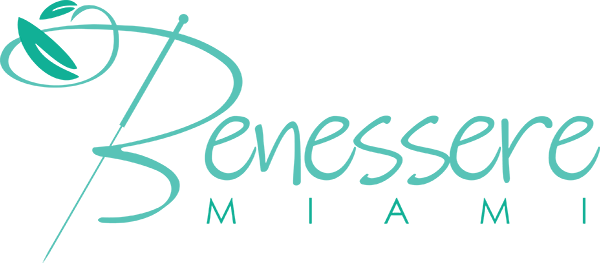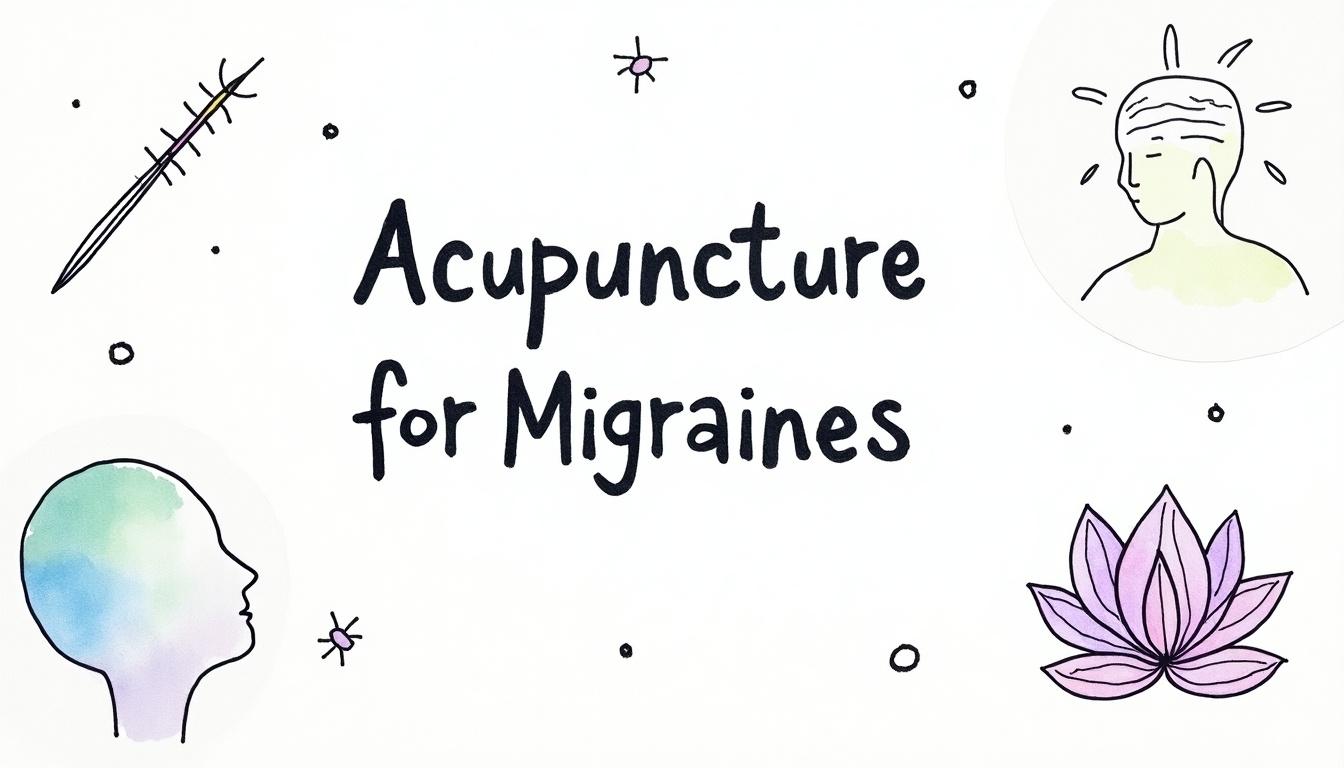Acupuncture for Migraines: What You Need to Know
Acupuncture is a practice from traditional Chinese medicine that involves inserting thin needles into specific points of the body. It is based on the idea that there are over 2,000 points connected by meridians, and blockages in energy flow can lead to issues like migraines. This therapy is thought to activate the nervous system, helping with pain relief and healing by releasing endorphins and improving blood circulation. Research shows it can significantly reduce the frequency and severity of migraines, making it an effective option for patients who don’t respond well to conventional treatments. However, consulting healthcare providers before starting is important for safety and effectiveness.
What is Acupuncture?

Acupuncture is a practice rooted in traditional Chinese medicine that involves the insertion of thin needles into specific points on the body. This technique is based on the concept that the body has over 2,000 acupuncture points connected by 14 pathways, known as meridians. According to this approach, disruptions in the flow of energy, or qi, can lead to various health issues, including migraines. By stimulating these points, acupuncture aims to restore balance and promote overall well-being. It is often viewed as a holistic approach to health, addressing not just the symptoms but also the underlying causes of conditions like migraines.
How Does Acupuncture Work?
Acupuncture is believed to work by stimulating the nervous system and influencing the body’s natural pain-relieving mechanisms. When thin needles are inserted into specific acupuncture points, it may trigger the release of endorphins, which are chemicals that help alleviate pain. Additionally, acupuncture is thought to enhance blood circulation, promoting healing and reducing inflammation. For instance, a study showed that targeting certain points on the body could lead to significant reductions in pain perception for migraine sufferers. The practice also helps to restore balance in the body, addressing underlying issues that may contribute to migraine frequency and intensity. This multifaceted approach makes acupuncture a compelling option for those seeking relief from migraines.
Research on Acupuncture for Migraines
Numerous studies have explored the effectiveness of acupuncture in treating migraines. A notable 2016 Cochrane review found that 57% of individuals undergoing acupuncture reported a significant decrease in headache frequency. This reduction was comparable to the outcomes seen with conventional medications. A broader review revealed that 59% of participants experienced at least a 50% reduction in migraine frequency after a series of acupuncture sessions. These findings suggest that acupuncture may be a beneficial alternative for those seeking relief from migraines, particularly when traditional treatments have failed. As more research emerges, the potential of acupuncture in migraine management continues to gain recognition in the medical community.
| Study | Findings | Percentage of Patients Reporting Improvement |
|---|---|---|
| 2016 Cochrane Review | Significant reduction in headache frequency | 57% |
| Comprehensive Review | Reduction of 50% or more in migraine frequency | 59% |
Suggested Treatment Plan
For individuals considering acupuncture for migraine relief, a recommended treatment plan often consists of up to 10 sessions over a period of 5 to 8 weeks. Each session typically lasts about 30 to 60 minutes. It is advisable to schedule treatments two to three times a week initially, gradually reducing the frequency as migraines become less severe or frequent.
Acupuncture is frequently recommended as a complementary treatment alongside conventional therapies, especially for those who find that medications do not provide adequate relief or cause unwanted side effects. For example, a patient might continue taking their prescribed migraine medication while attending acupuncture sessions to enhance their overall treatment outcomes.
During the initial sessions, the acupuncturist may conduct a thorough assessment to identify specific triggers and tailor the treatment according to the individual’s unique symptoms and lifestyle. This may involve focusing on specific acupuncture points known to relieve migraine pain and improve overall well-being.
It’s important for patients to maintain open communication with both their acupuncturist and healthcare provider to monitor progress and adjust the treatment plan as necessary. This collaborative approach can enhance the effectiveness of the acupuncture treatment and ensure that it aligns with the patient’s health goals.
- Initial consultation with a qualified acupuncturist
- Regular acupuncture sessions (weekly or biweekly)
- Incorporating relaxation techniques alongside treatments
- Maintaining a migraine diary to track triggers and progress
- Combining acupuncture with other holistic treatments (e.g., herbal medicine)
- Lifestyle modifications to complement acupuncture (diet, sleep, stress management)
Different Types of Acupuncture
There are several types of acupuncture, each with its own approach and philosophy. Traditional Chinese Acupuncture focuses on balancing the body’s energy, or qi, by stimulating specific points along the meridians. This technique often includes holistic practices like dietary advice and herbal treatments to enhance overall well-being. On the other hand, Western Medical Acupuncture takes a more scientific approach, understanding the effects of acupuncture on the nervous system. It often employs both local points, near the area of pain, and distal points, which may be farther away, to relieve symptoms. This method is more aligned with modern medical practices and research findings.
Is Acupuncture Safe?
Acupuncture is generally regarded as a safe practice when performed by a qualified and licensed practitioner. The insertion of needles is typically painless and the risk of serious side effects is low. However, like any medical treatment, it is not without its potential downsides. Some common side effects may include minor bruising, soreness at the needle sites, fatigue, or temporary worsening of symptoms. In rare cases, there could be a slight risk of infection if non-sterile needles are used.
To ensure safety, it is important to seek treatment from certified acupuncturists who follow proper hygiene and safety protocols. This includes using single-use, sterile needles and maintaining a clean treatment environment. Patients with certain health conditions, such as bleeding disorders or those on anticoagulant medications, should consult their healthcare provider before starting acupuncture to avoid complications.
Ultimately, while acupuncture can be a beneficial treatment option for migraines, it’s essential for patients to discuss any concerns about safety with their healthcare provider to ensure it fits well into their overall migraine management plan.
Health Organization Recommendations

Health organizations have recognized acupuncture as a valid treatment option for migraines. The National Institute for Health and Care Excellence (NICE) suggests that acupuncture can be beneficial for chronic tension-type headaches and migraines, especially when conventional medications are ineffective or unsuitable for the patient. Additionally, the American Academy of Neurology has noted that acupuncture may be an effective treatment for migraine prevention. It is recommended that patients discuss the possibility of acupuncture with their healthcare providers to ensure it fits into their overall treatment strategy and to consider any potential interactions with existing medications or therapies.
Lifestyle Tips for Migraine Management
Managing migraines often requires a holistic approach that includes lifestyle changes. Staying hydrated is crucial; dehydration can trigger migraines, so aim for at least eight glasses of water a day. Establishing a regular sleep schedule also plays a significant role in preventing attacks. Going to bed and waking up at the same time daily helps regulate your body’s internal clock.
Stress management techniques, such as yoga, meditation, or deep-breathing exercises, can significantly reduce the frequency of migraines. Physical activity is also beneficial; regular exercise can help alleviate stress and improve overall health. However, it’s essential to find a balance, as overexertion can sometimes trigger migraines.
Dietary choices are important too. Keeping a food diary can help identify potential triggers, such as caffeine, alcohol, aged cheeses, or processed foods. Once identified, it’s best to avoid these foods. Eating smaller, more frequent meals can help maintain stable blood sugar levels, which may also prevent migraines.
Finally, consider creating a migraine-friendly environment. Reduce exposure to bright lights, loud noises, and strong smells, as these can be triggers for many individuals. By incorporating these lifestyle changes alongside acupuncture, you can create a comprehensive strategy for managing migraines.
Insurance and Acupuncture Coverage
Insurance coverage for acupuncture can be quite variable depending on the provider and the specific policy. Some insurance plans may cover acupuncture treatments for certain conditions, including migraines, while others may not offer any coverage at all. It’s important for patients to contact their insurance company directly to inquire about their specific plan’s benefits related to acupuncture. They should ask questions such as whether acupuncture is covered, if there are any specific conditions that need to be met for coverage, and what documentation may be required from the acupuncturist. Additionally, some practices might offer payment plans or sliding scale fees for those whose insurance does not cover acupuncture, making it more accessible for patients seeking relief from migraines.
Final Thoughts on Acupuncture for Migraines
Acupuncture offers a promising option for those seeking relief from migraines, especially for patients who have not found success with traditional medications. Its ability to reduce the frequency and severity of migraine attacks can be a game-changer for many. Additionally, the holistic nature of acupuncture encourages a broader approach to health, often integrating lifestyle changes that can further enhance treatment outcomes. While individual experiences may vary, the positive findings from various studies and health organizations lend credibility to acupuncture as a legitimate alternative or complementary therapy. It’s always best for individuals to discuss treatment plans with their healthcare providers, ensuring that acupuncture fits well within their overall migraine management strategy.
Frequently Asked Questions
1. How does acupuncture help with migraines?
Acupuncture may help relieve migraines by stimulating certain points on the body, promoting relaxation, and improving blood flow, which can reduce pain and frequency of attacks.
2. Is acupuncture safe for treating migraines?
Yes, acupuncture is generally considered safe when performed by a trained professional. Side effects are rare but can include soreness or minor bruising at the needle sites.
3. How many acupuncture sessions are usually needed to see results for migraines?
Many people find relief after a few sessions, but the number can vary. Some may need several treatments over weeks to notice significant improvements.
4. Can acupuncture be used alongside other migraine treatments?
Yes, acupuncture can be used alongside medications or other therapies. Always consult with your healthcare provider to create a comprehensive treatment plan.
5. Are there specific acupuncture points that are effective for migraines?
Yes, certain points like those on the head, neck, and wrists are commonly targeted. A trained acupuncturist will choose points based on your specific condition.
Takeaway (TL;DR)
Acupuncture is a traditional Chinese medicine technique involving needle insertion to manage migraines. It may relieve pain by stimulating the nervous system and releasing endorphins. Research shows it can significantly reduce migraine frequency and severity, with recommended treatment often involving up to 10 sessions. While generally safe, patients should choose certified practitioners to minimize side effects. Health organizations support its use, especially for those who don’t respond well to conventional therapies. Lifestyle changes and checking insurance coverage for acupuncture are also important considerations.
 English
English  Spanish
Spanish  Portuguese
Portuguese 




